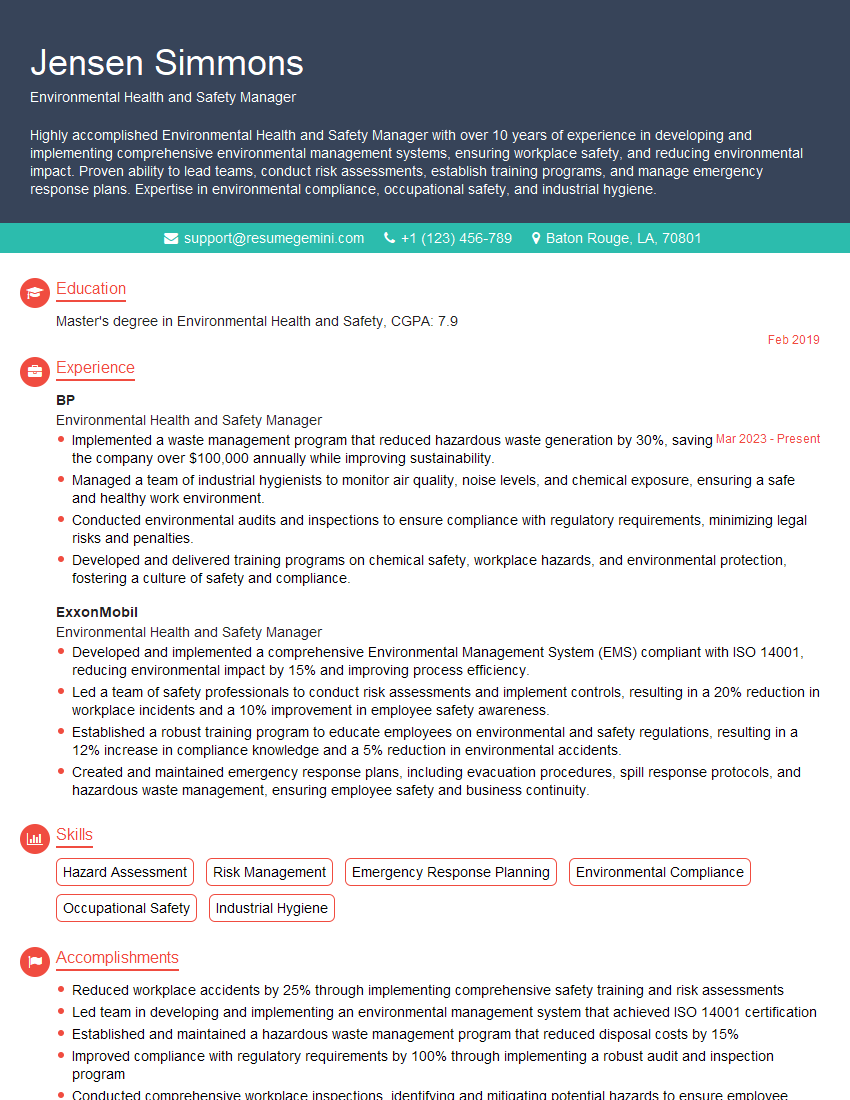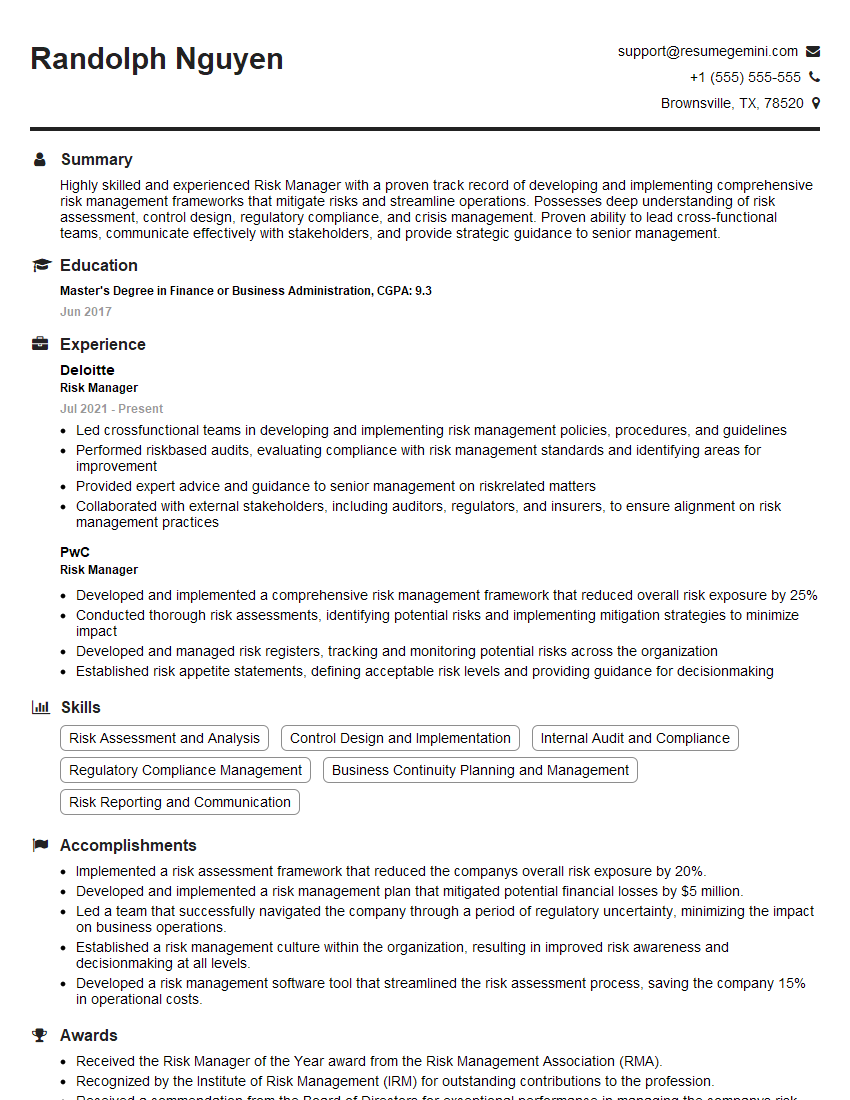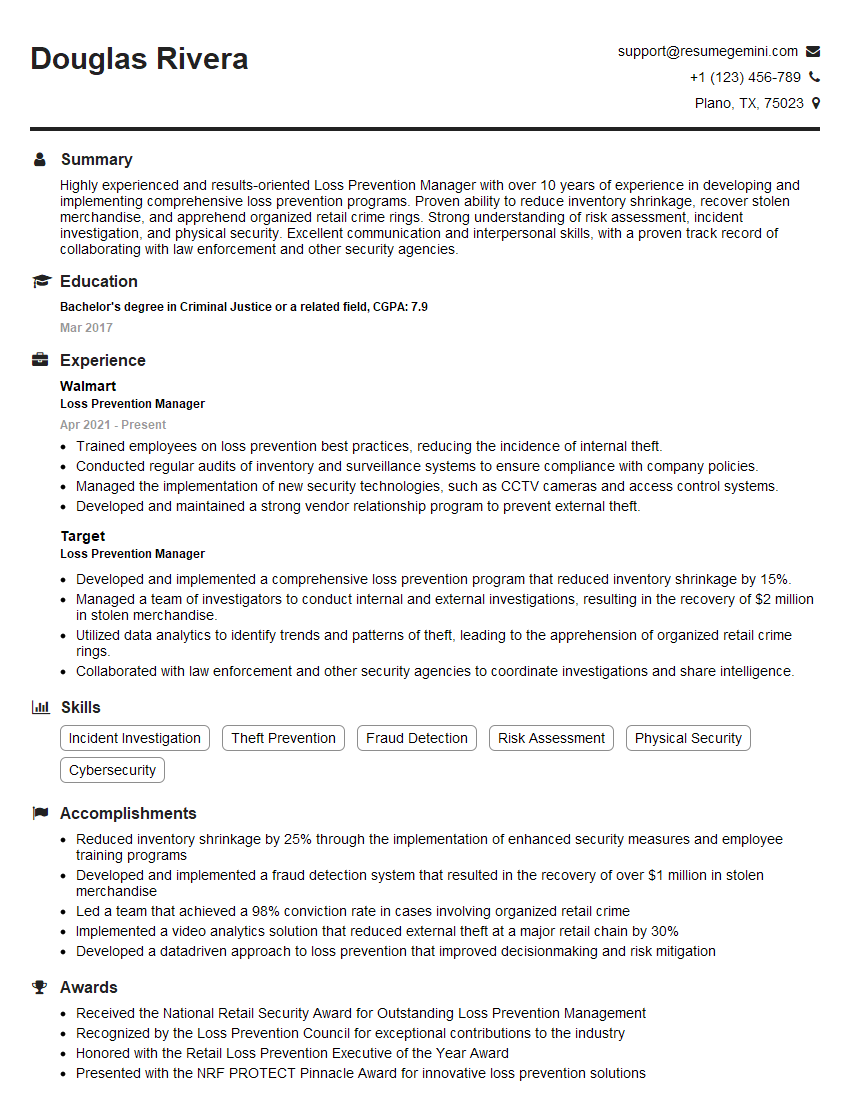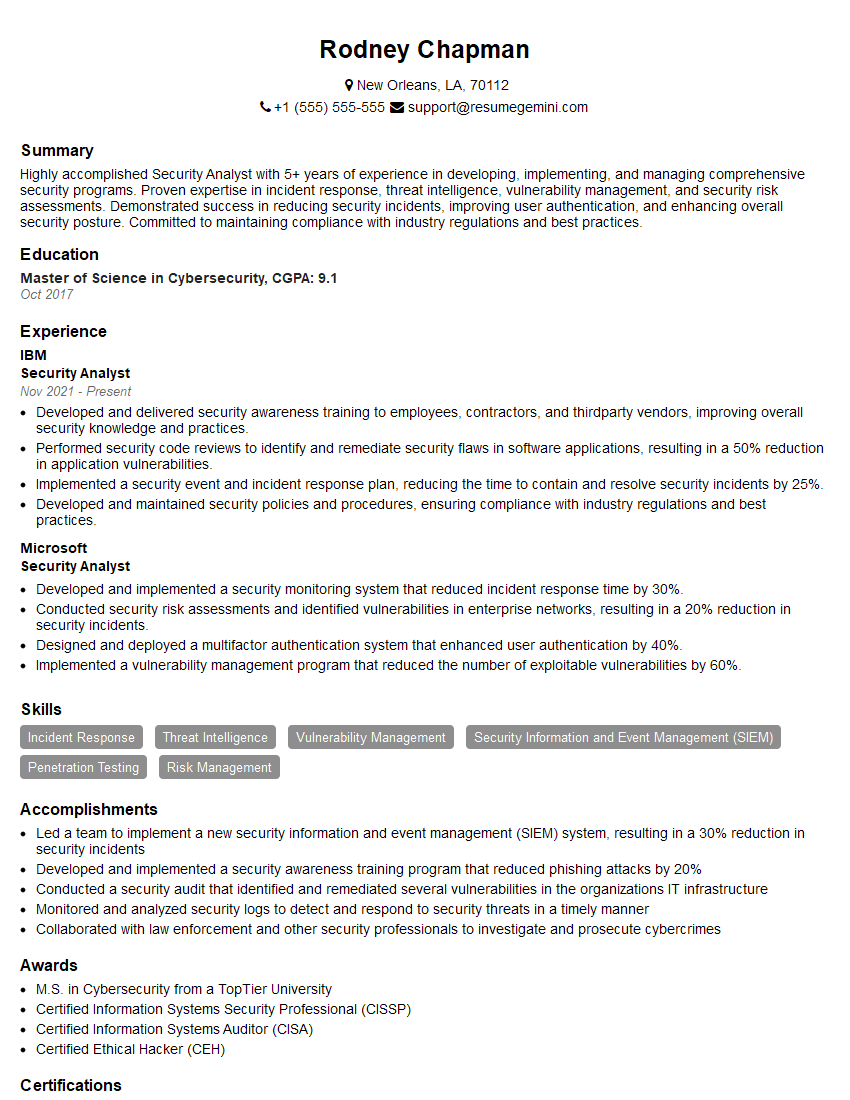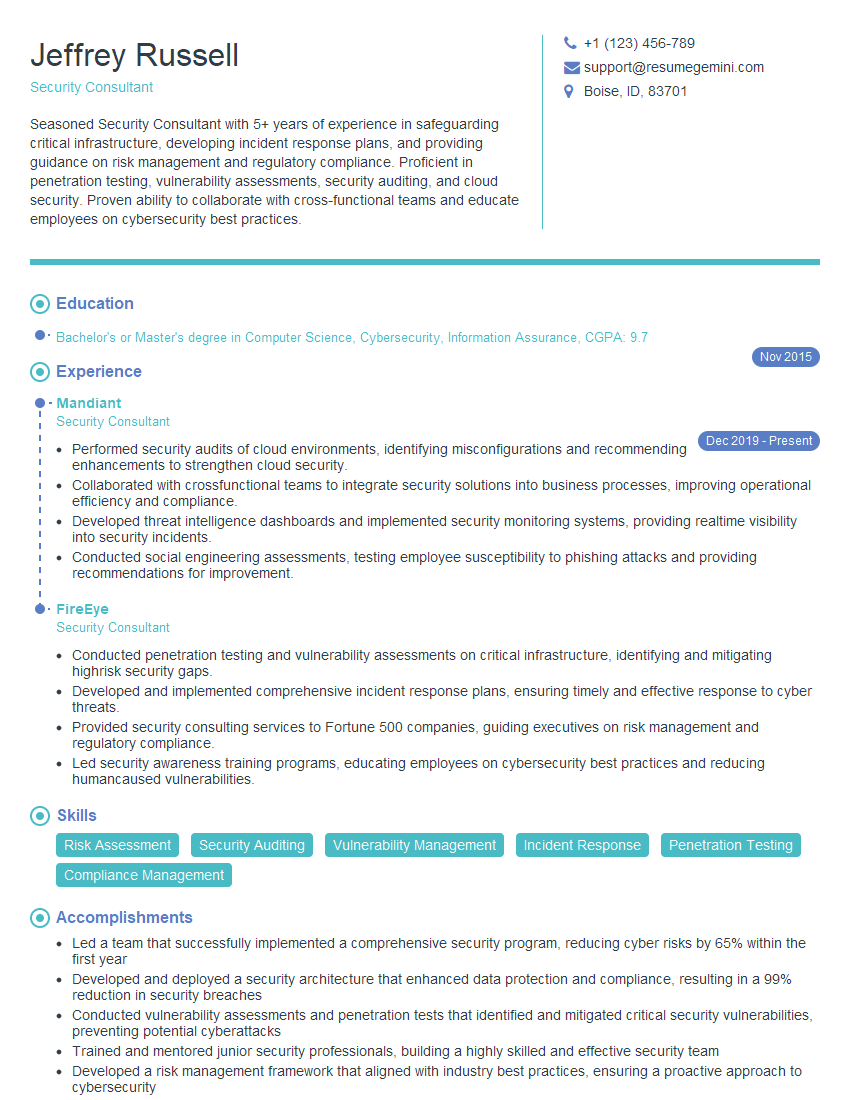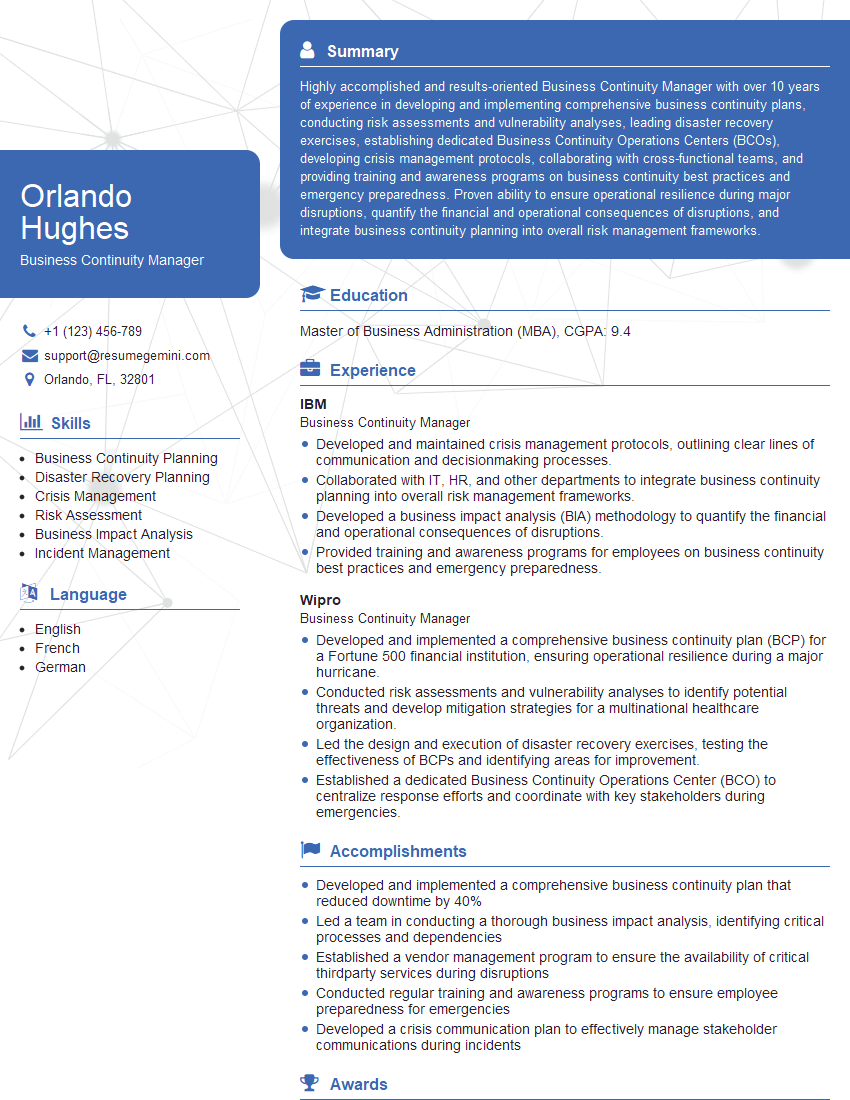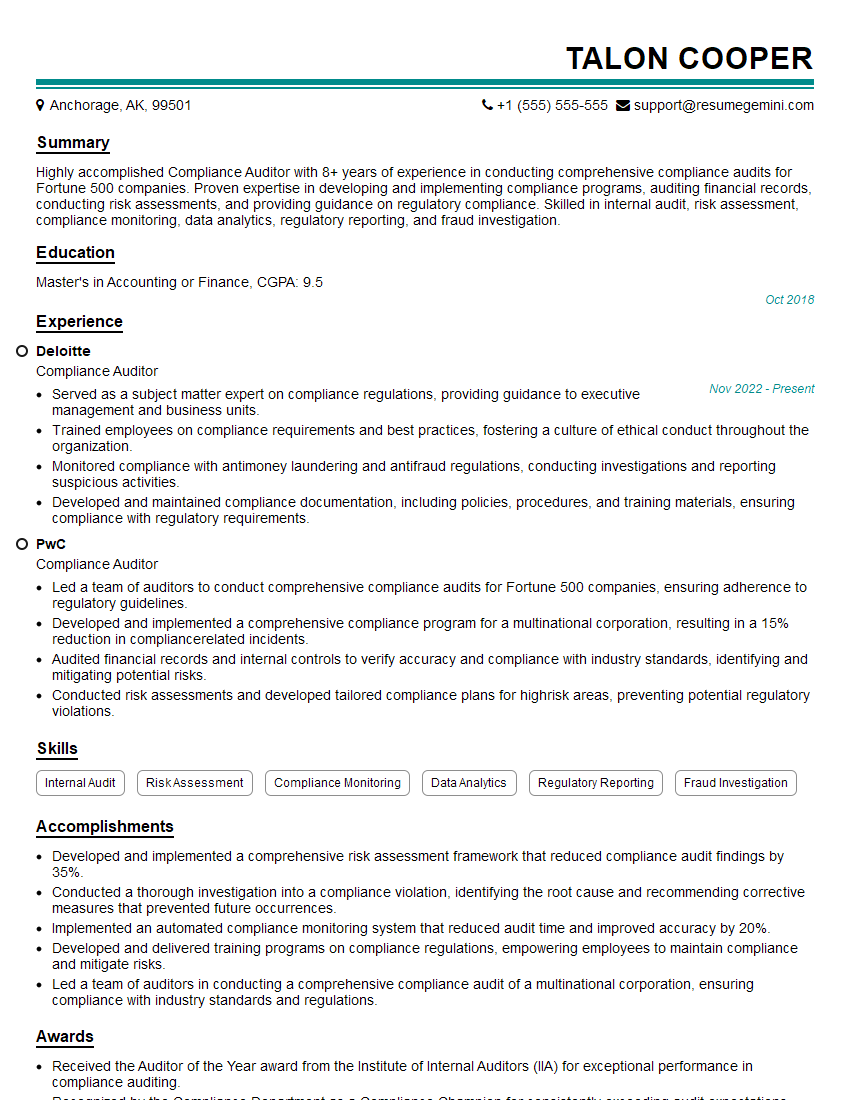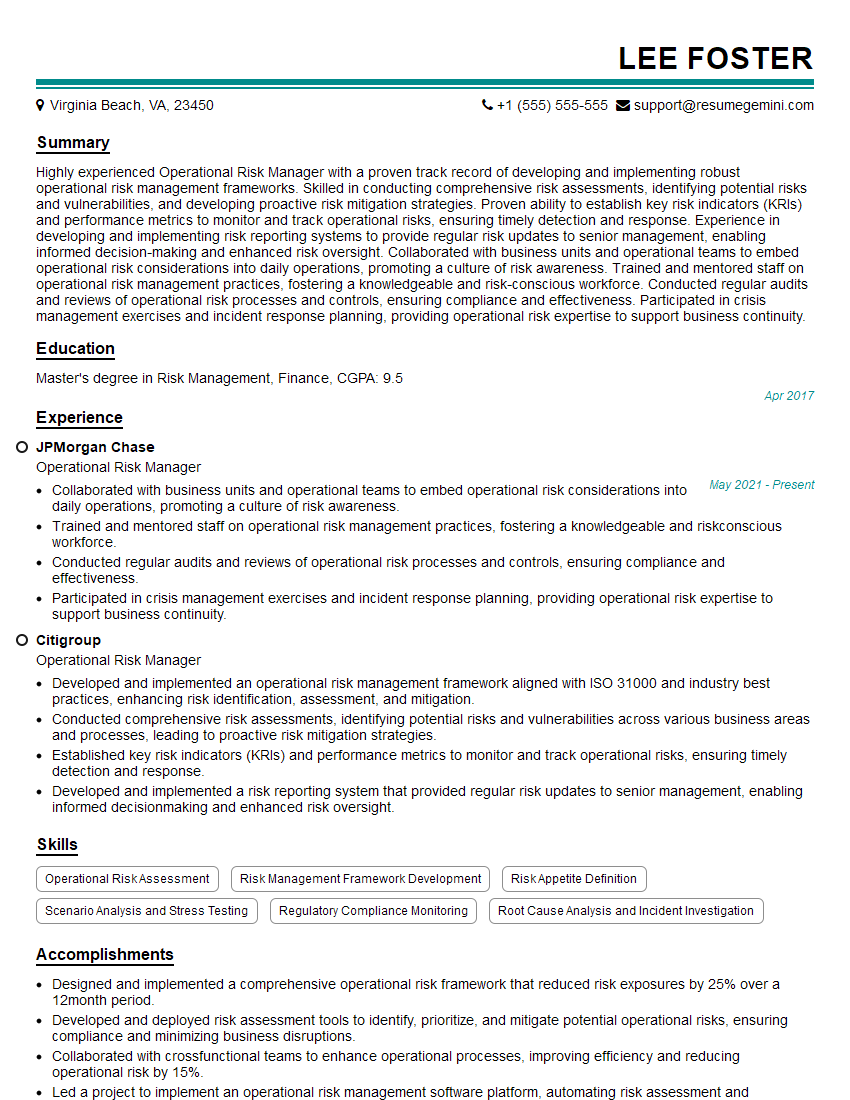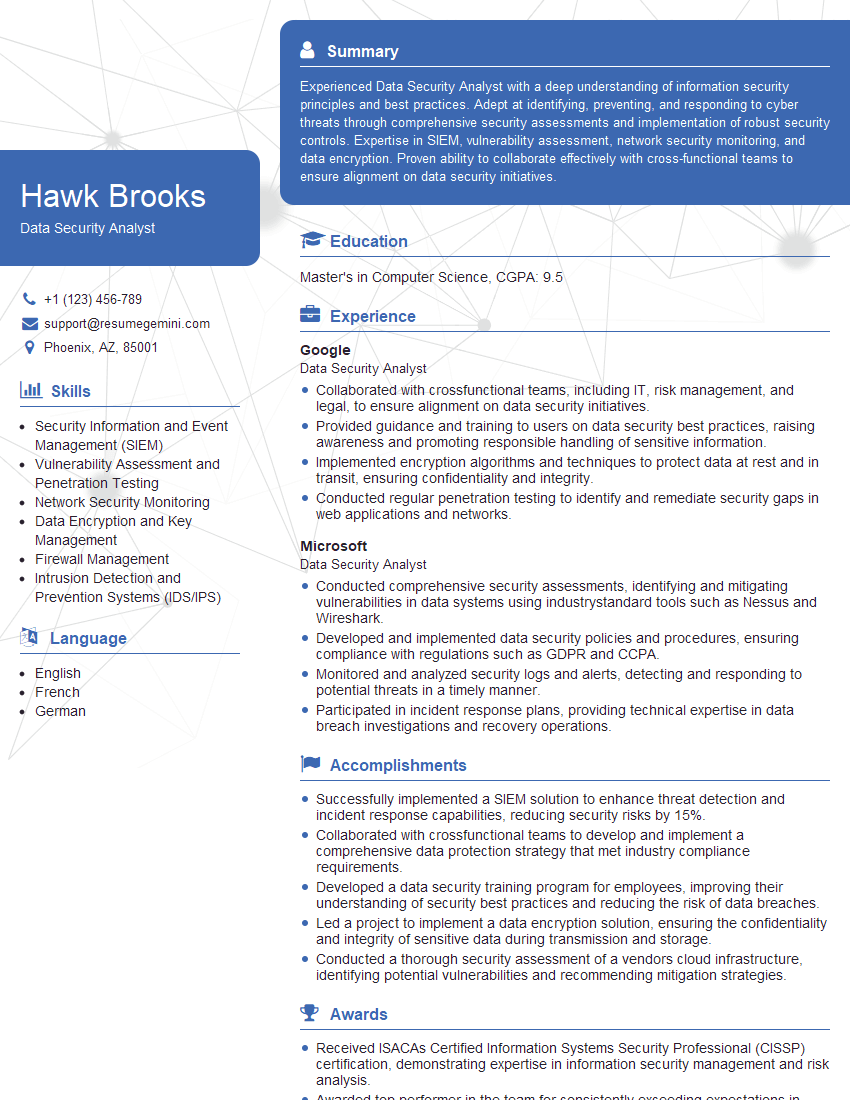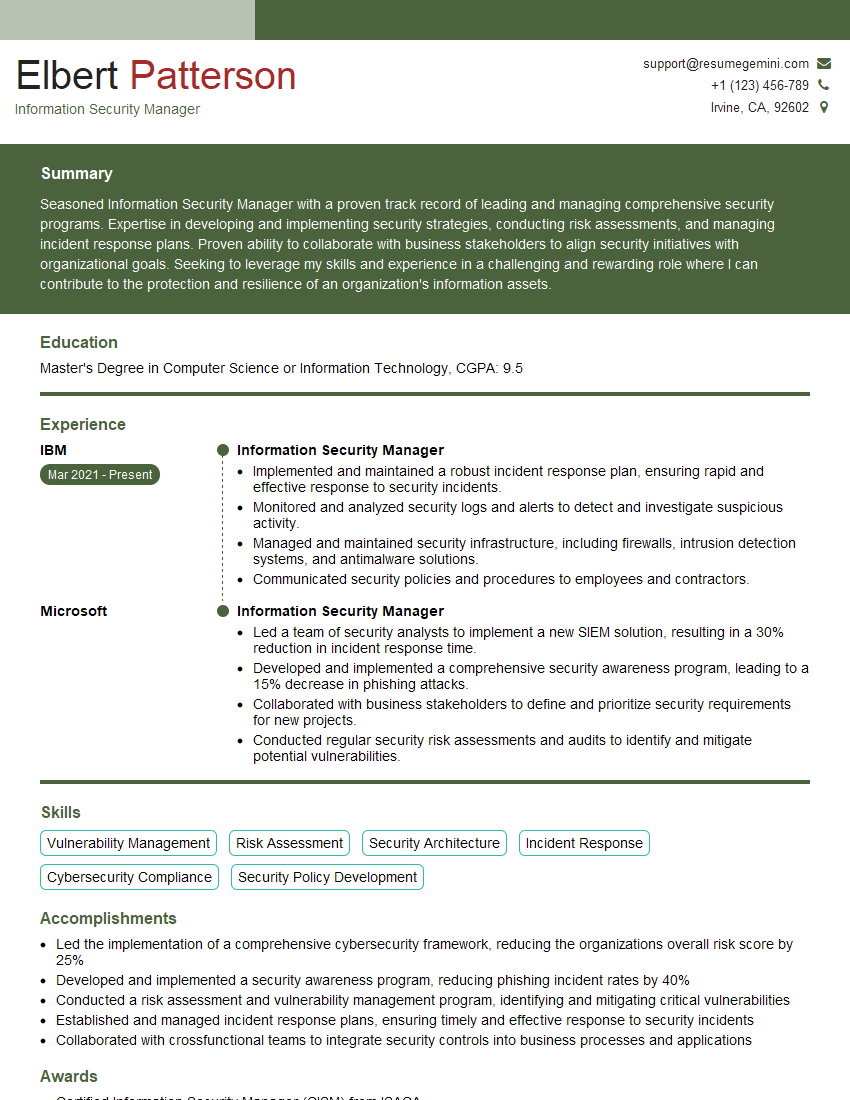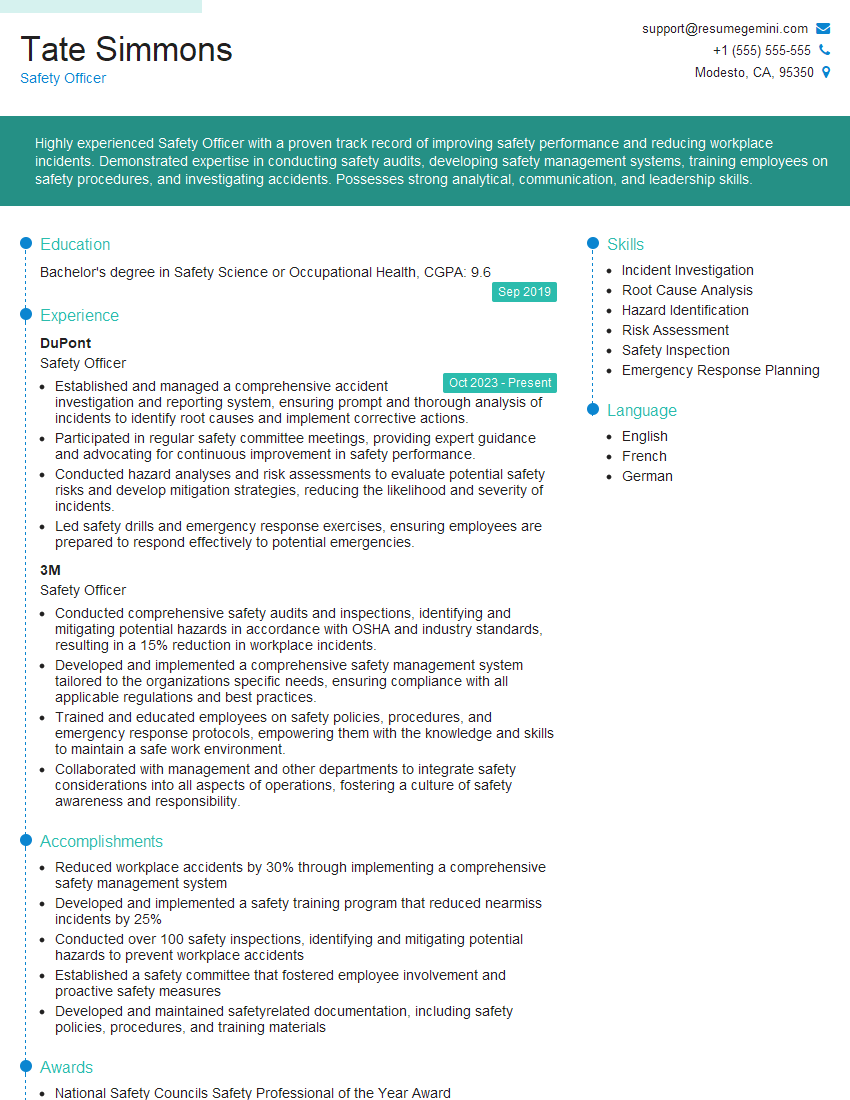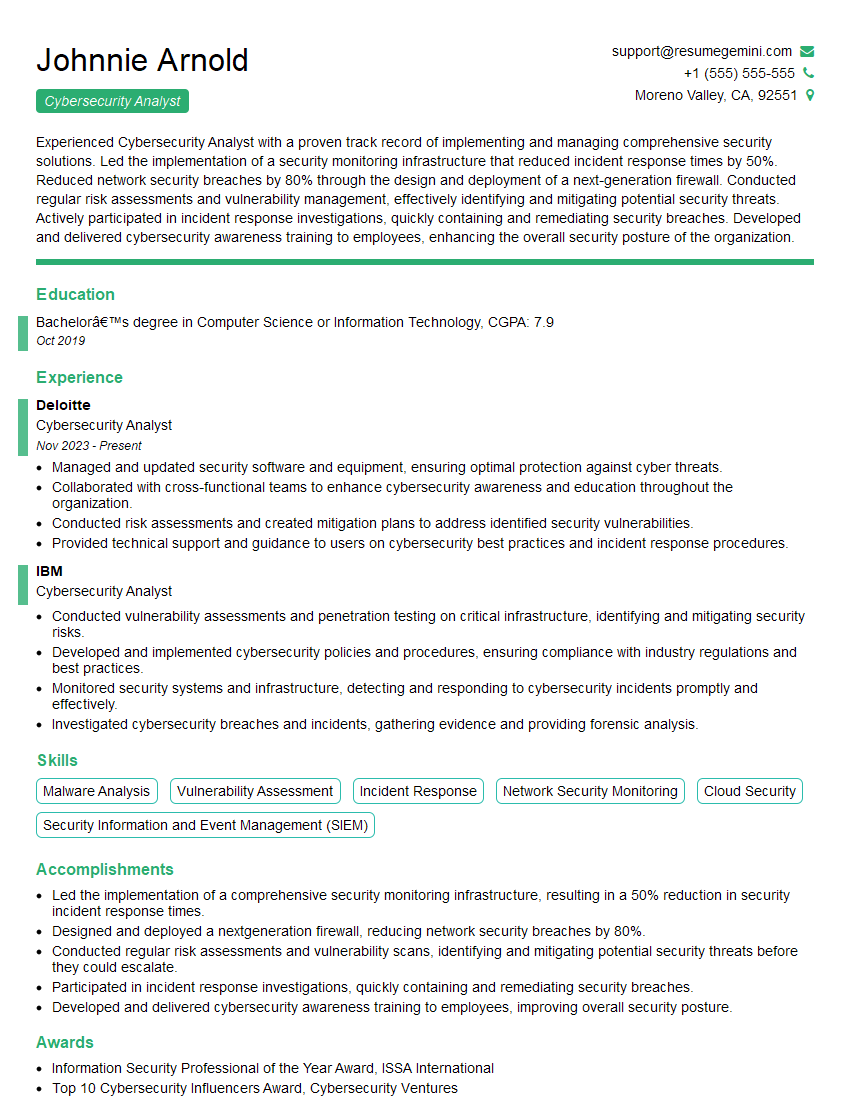Preparation is the key to success in any interview. In this post, we’ll explore crucial Experience in Risk Assessment and Mitigation interview questions and equip you with strategies to craft impactful answers. Whether you’re a beginner or a pro, these tips will elevate your preparation.
Questions Asked in Experience in Risk Assessment and Mitigation Interview
Q 1. Explain the difference between qualitative and quantitative risk assessment.
Qualitative and quantitative risk assessments differ primarily in how they measure and describe risk. Qualitative assessment uses descriptive terms and scales to evaluate risk likelihood and impact, focusing on subjective judgments and expert opinions. Think of it like using words to describe how dangerous something is – ‘low,’ ‘medium,’ ‘high’. Quantitative assessment, on the other hand, employs numerical data and statistical methods to analyze risk. It uses concrete numbers to quantify the likelihood and impact of events, enabling more precise risk comparison and prioritization. Imagine instead of saying ‘high risk’, you say ‘there’s a 70% chance of this event causing a $100,000 loss’.
Example: Imagine assessing the risk of a new software launch. A qualitative assessment might say ‘the risk of a critical bug is medium to high, based on the complexity of the code and the lack of extensive testing.’ A quantitative assessment might say ‘based on historical data from similar projects, there is a 30% probability of a critical bug causing a $50,000 loss in revenue within the first month.’
Q 2. Describe your experience with different risk assessment methodologies (e.g., FMEA, PHA, SWOT).
Throughout my career, I’ve extensively used several risk assessment methodologies. Failure Mode and Effects Analysis (FMEA) is a systematic approach to identify potential failures in a system or process, analyze their effects, and implement preventive measures. I’ve used FMEA extensively in product development, ensuring we identify potential failure points before launch. For instance, I led an FMEA for a new medical device, identifying potential issues related to component failures and user error, allowing for design modifications and improved user instructions.
Preliminary Hazard Analysis (PHA) is frequently used in early project phases to identify potential hazards and risks. In a recent project concerning a new chemical processing plant, I guided the team through a PHA to list potential hazards like chemical spills or explosions, determining the severity and likelihood of each, leading to better safety protocols.
Finally, SWOT analysis, while not strictly a risk assessment methodology, helps identify strengths, weaknesses, opportunities, and threats impacting a project. I’ve incorporated SWOT into risk assessments by evaluating external factors (opportunities and threats) and internal capabilities (strengths and weaknesses) to provide a holistic risk profile. For example, I integrated a SWOT analysis into a new market entry strategy, highlighting potential market threats (competitors) and internal weaknesses (lack of brand recognition) as crucial risk factors.
Q 3. How do you prioritize risks?
Risk prioritization is crucial for effective risk management. I typically use a risk matrix that combines the likelihood and impact of each identified risk. The likelihood refers to the probability of the risk occurring, while the impact considers the potential consequences if it does occur. These are often rated using qualitative scales (e.g., low, medium, high) or quantitative scales (e.g., percentages or monetary values). Risks are then plotted on a matrix where higher likelihood and impact translate to higher priority.
Example: A risk with a high likelihood and high impact (e.g., a major system failure causing significant financial losses) would be prioritized higher than a risk with low likelihood and low impact (e.g., minor user interface issues). Further, I sometimes use techniques like weighted scoring, assigning weights to likelihood and impact based on the specific context of the project. This helps account for different levels of importance for varying aspects of a project.
Q 4. What are the key elements of a comprehensive risk management plan?
A comprehensive risk management plan has several key elements: First, risk identification, where all potential risks are systematically identified through brainstorming, checklists, and historical data analysis. Second, risk analysis, involving qualitative or quantitative assessment to understand the likelihood and impact of each identified risk. Then comes risk evaluation, prioritizing risks based on their severity and potential consequences. Fourth, risk treatment, selecting appropriate mitigation strategies for each prioritized risk, such as avoidance, reduction, transfer, or acceptance. Finally, risk monitoring and review, a continuous process of tracking identified risks, evaluating the effectiveness of mitigation strategies, and adapting the plan as needed.
The plan should also include clear responsibilities, timelines, and budget allocations for each phase of the process. Regular reporting and communication to stakeholders are also essential.
Q 5. Explain the concept of residual risk.
Residual risk is the risk that remains after implementing risk mitigation strategies. It’s the level of uncertainty that cannot be entirely eliminated or transferred. It’s important to remember that risk management doesn’t aim for zero risk, but rather to reduce risk to an acceptable level. Residual risk is that acceptable level; a level of risk the organization is willing to tolerate based on its risk appetite.
Example: A company implements security measures (e.g., firewalls, intrusion detection systems) to reduce the risk of a cyberattack. Despite these measures, there remains a residual risk of a successful attack, perhaps due to unforeseen vulnerabilities or human error. The organization accepts this residual risk because the cost and effort of completely eliminating the risk outweigh the potential benefits.
Q 6. How do you communicate risk information to different stakeholders?
Communicating risk information effectively to diverse stakeholders is crucial. I tailor my communication approach to the audience, considering their technical expertise and level of interest. For technical audiences, I use precise data and quantitative analyses, while for non-technical audiences, I prioritize clear and concise summaries, visualizations (e.g., charts and graphs), and analogies.
For example, when communicating to senior management, I would focus on the overall financial impact and strategic implications of risks. When communicating to project teams, I would concentrate on specific actions and responsibilities related to risk mitigation. I also leverage different communication channels, such as reports, presentations, and regular meetings, to keep stakeholders informed and engaged.
Q 7. Describe your experience with risk mitigation strategies.
My experience encompasses a wide range of risk mitigation strategies. Risk avoidance involves eliminating the risk entirely, such as not undertaking a project with high inherent risks. Risk reduction aims to lessen the likelihood or impact of a risk through actions like improved safety procedures or enhanced security measures. For instance, implementing a robust testing procedure reduces the risk of software bugs.
Risk transfer shifts the risk to a third party, such as through insurance or outsourcing. For example, a company might purchase insurance to cover potential financial losses from a natural disaster. Finally, risk acceptance involves acknowledging the risk and deciding to bear the potential consequences. This might be chosen when the cost of mitigation outweighs the potential impact of the risk.
Selecting the appropriate strategy depends on various factors such as risk severity, cost of mitigation, and organizational risk appetite. I often employ a combination of strategies to effectively manage a portfolio of risks.
Q 8. How do you identify and assess emerging risks?
Identifying and assessing emerging risks involves a proactive and systematic approach. It’s not just about reacting to problems; it’s about anticipating them. My process typically begins with environmental scanning. This involves monitoring various sources, including industry news, regulatory changes, technological advancements, economic trends, and geopolitical events, to identify potential threats and opportunities. I also leverage horizon scanning, a more forward-looking approach that explores long-term trends and potential disruptions.
Once potential emerging risks are identified, I employ a structured assessment framework. This often involves qualitative methods like brainstorming sessions with stakeholders and expert interviews. Quantitative analysis, such as scenario planning and probabilistic modelling, may be applied where sufficient data exists. The assessment considers factors like likelihood, impact, and velocity (how quickly the risk may materialize). This allows prioritization of the most critical emerging risks.
For example, during my time at [Previous Company Name], we identified the emerging risk of a major cyberattack targeting our supply chain. Through horizon scanning, we’d noticed increasing sophisticated cyberattacks targeting similar companies. We then assessed the likelihood and impact, ultimately implementing enhanced cybersecurity measures across the supply chain to mitigate this emerging risk.
Q 9. How do you use key risk indicators (KRIs) in your work?
Key Risk Indicators (KRIs) are crucial for ongoing risk monitoring and early warning. They act as the ‘canary in the coal mine,’ providing signals of potential problems before they escalate into significant incidents. I use KRIs to continuously track the health of our risk profile, allowing for proactive intervention.
My approach involves selecting KRIs that are:
- Specific and Measurable: Clearly defined and easily quantifiable.
- Actionable: Provide clear insights that enable corrective action.
- Relevant: Directly related to identified risks.
- Timely: Reported frequently enough to identify trends and potential issues.
For instance, in a project management context, a KRI might be the number of critical defects detected during testing. A steady increase in this KRI would signal a potential problem with quality control, enabling intervention before release. I regularly review KRI dashboards, analyzing trends and deviations from established baselines. This allows me to identify emerging risks or weaknesses in existing controls. This data-driven approach ensures a proactive and efficient risk management process.
Q 10. What is your experience with risk registers?
Risk registers are central to my risk management practice. They are dynamic documents that provide a centralized repository of all identified risks, their associated likelihood and impact, planned responses, and owners. I’ve used risk registers in various capacities, from small projects to large enterprise-wide initiatives.
I ensure that our risk registers are:
- Comprehensive: Including all identified risks, both internal and external.
- Well-structured: Using consistent templates and terminology for clear communication.
- Regularly updated: Reflecting changes in the risk landscape and implemented mitigation strategies.
- Accessible: Easily accessible to relevant stakeholders through secure platforms.
I typically utilize software tools for managing risk registers, which enable features such as automated reporting, trend analysis, and collaboration capabilities. The register’s effectiveness is regularly reviewed to ensure it continues to provide relevant and actionable information.
Q 11. Describe a situation where you had to escalate a risk.
During a large-scale software implementation project, we identified a critical risk related to data migration. The initial assessment suggested a moderate likelihood and significant impact. However, during a subsequent technical review, the likelihood was significantly reassessed as high. The potential data loss could have severe financial and reputational consequences.
I immediately escalated this risk to senior management. This wasn’t a simple email; it involved a formal presentation summarizing the risk, outlining the revised likelihood and impact, and proposing immediate mitigation actions. The presentation included a detailed risk assessment report, alternative solutions, and a proposed contingency plan. This proactive escalation ensured immediate attention and the allocation of resources necessary to prevent a major incident. The prompt response prevented significant data loss and minimized the project’s overall impact.
Q 12. How do you handle conflicting priorities in risk management?
Conflicting priorities are inevitable in risk management. Resources are always limited, and competing demands often emerge. My approach prioritizes risks based on a combination of their likelihood, impact, and urgency. I often use a risk matrix to visualize and compare these factors, ensuring objective prioritization.
Stakeholder engagement is vital. Transparent communication and collaborative decision-making are key to resolving conflicts. This involves explaining the rationale behind prioritization decisions, addressing concerns, and building consensus. When necessary, I may employ techniques like negotiation and compromise to reach mutually acceptable solutions. Prioritization is documented and revisited regularly to ensure alignment with changing circumstances.
A practical example involved a project facing simultaneous risks related to budget overruns and security vulnerabilities. Through stakeholder engagement and a structured prioritization process, we agreed to address the security vulnerabilities first due to their potentially higher impact, even though it resulted in a minor budget overrun. This prioritized approach minimized overall project risk.
Q 13. Explain your understanding of regulatory compliance related to risk management.
Regulatory compliance is paramount in risk management. My understanding encompasses various regulations depending on the industry and geographic location. These regulations often dictate specific risk management practices, control frameworks, and reporting requirements.
For example, in the financial sector, compliance with regulations like GDPR (General Data Protection Regulation) and SOX (Sarbanes-Oxley Act) mandates specific risk management practices relating to data security, financial reporting, and internal controls. I stay abreast of evolving regulations through continuous professional development and engagement with regulatory bodies. Our risk management framework is designed to proactively address and demonstrate compliance with all relevant regulations. Failure to comply can lead to significant penalties, legal action, and reputational damage.
A key aspect of regulatory compliance is maintaining accurate and auditable records, including risk assessments, mitigation plans, and audit trails. Regular internal audits and independent reviews help to ensure that our risk management program effectively addresses regulatory requirements.
Q 14. What is your experience with developing and implementing risk mitigation controls?
Developing and implementing risk mitigation controls is a core part of my expertise. This involves a structured process that begins with identifying specific controls for each risk. These controls aim to reduce the likelihood or impact of the risk, or both.
I usually leverage a combination of preventive and detective controls. Preventive controls aim to stop incidents from happening in the first place (e.g., access controls, security protocols). Detective controls help identify incidents that have already occurred (e.g., intrusion detection systems, audit trails). The selection of controls depends on factors such as cost-effectiveness, feasibility, and impact on business operations.
Implementation involves defining roles and responsibilities, providing training, establishing monitoring procedures, and integrating controls into existing processes. Regular reviews and updates are essential to ensure their effectiveness. For instance, in a previous project, we implemented multi-factor authentication to mitigate the risk of unauthorized access, a preventive control. We also implemented intrusion detection systems as a detective control to help identify and respond to potential attacks after they occurred. The success of mitigation efforts is regularly monitored and measured using KRIs and other performance indicators.
Q 15. How do you measure the effectiveness of risk mitigation strategies?
Measuring the effectiveness of risk mitigation strategies requires a multi-faceted approach. It’s not simply about whether a mitigation was implemented, but whether it achieved its intended effect. We need to assess whether the risk’s likelihood and/or impact have been reduced to an acceptable level.
Firstly, we establish Key Risk Indicators (KRIs) before implementing any mitigation. These are measurable metrics that reflect the risk’s state. For example, if the risk is ‘supplier failure,’ a KRI might be ‘percentage of orders delivered on time.’ Post-mitigation, we track these KRIs to see if they’ve improved.
Secondly, we conduct post-implementation reviews. These involve comparing the risk profile before and after the mitigation. Did the likelihood or impact change as predicted? We also analyze any unforeseen consequences. Perhaps the mitigation created a new, smaller risk.
Finally, we use a combination of qualitative and quantitative methods. Qualitative methods involve interviews and assessments of the effectiveness of the controls and procedures. Quantitative methods involve reviewing data, such as the number of incidents, financial losses, or project delays.
For instance, in a previous project involving a critical software launch, the risk of a major system failure was mitigated through rigorous testing and a robust backup system. We tracked the number of critical bugs found during testing (KRI) and compared it to past projects. Post-launch, we monitored system uptime and the number of reported failures. The significant reduction in both indicated the success of our mitigation strategy.
Career Expert Tips:
- Ace those interviews! Prepare effectively by reviewing the Top 50 Most Common Interview Questions on ResumeGemini.
- Navigate your job search with confidence! Explore a wide range of Career Tips on ResumeGemini. Learn about common challenges and recommendations to overcome them.
- Craft the perfect resume! Master the Art of Resume Writing with ResumeGemini’s guide. Showcase your unique qualifications and achievements effectively.
- Don’t miss out on holiday savings! Build your dream resume with ResumeGemini’s ATS optimized templates.
Q 16. How do you ensure that risk assessments are regularly reviewed and updated?
Regular review and updates of risk assessments are crucial because risks are dynamic; they change constantly due to internal and external factors. To ensure this, we implement a structured, cyclical approach.
Firstly, we establish a formal review schedule. This might involve monthly, quarterly, or annual reviews depending on the project’s nature and the volatility of the risk environment.
Secondly, we use trigger events to prompt unscheduled reviews. These events could include significant changes in the project scope, regulatory changes, unforeseen incidents, or any other significant event that could impact the identified risks.
Thirdly, we employ a documented process. This includes clear procedures for identifying changes to the risk landscape, reassessing the likelihood and impact of risks, updating mitigation strategies, and documenting all changes. This ensures traceability and accountability.
Finally, the review process should involve a multi-disciplinary team. This allows for a more comprehensive and balanced assessment of the risks involved, incorporating different perspectives and expertise.
Imagine a project building a bridge. A scheduled quarterly review might examine the weather patterns and their potential impact on construction. An unscheduled review might be triggered by a sudden landslide that alters the terrain.
Q 17. Describe your experience with using risk assessment software or tools.
I have extensive experience using several risk assessment software tools, most recently, Risk Management Pro and Archer. These tools aid in the entire risk management lifecycle, from initial identification and analysis to mitigation planning and monitoring.
Risk Management Pro, for example, allows for sophisticated quantitative risk analysis using Monte Carlo simulations. This helped us to model the probability of different outcomes in a complex infrastructure project, providing a much clearer picture of potential cost overruns and schedule delays.
Archer provides a robust platform for collaborative risk management, facilitating effective communication and information sharing among stakeholders. The tool’s built-in workflow features ensure that risk assessments are reviewed and updated in a timely and efficient manner. We utilized its reporting functionalities to generate dashboards displaying key risk indicators, allowing for proactive monitoring and timely intervention.
Beyond these specific tools, my experience includes using spreadsheets for simpler projects and creating custom databases for bespoke risk management needs. The choice of tool always depends on project complexity, budget, and stakeholder needs.
Q 18. How do you deal with uncertainty in risk assessment?
Uncertainty is inherent in risk assessment; we can rarely predict the future with absolute certainty. My approach involves using a combination of techniques to handle this.
Firstly, I employ sensitivity analysis. This involves systematically changing the inputs of our risk model (e.g., likelihood and impact estimates) to see how sensitive the overall risk assessment is to those changes. This highlights areas of high uncertainty which requires further investigation.
Secondly, I incorporate expert elicitation. This involves consulting with subject matter experts to obtain informed judgments about the likelihood and impact of uncertain events. We use structured methods to ensure consistency and reduce bias.
Thirdly, I use scenario planning. This involves developing a range of plausible scenarios representing different possible futures. This helps us anticipate a broader range of potential outcomes and prepare appropriate mitigation strategies for each.
Lastly, I emphasize the importance of regular monitoring and adaptive management. Since uncertainty is unavoidable, we must continuously monitor the risk landscape and adjust our mitigation strategies as new information becomes available. It’s often better to prepare for a range of potential outcomes instead of relying on a single prediction.
Q 19. What is your approach to managing risks in a project?
My approach to managing risks in a project is proactive and integrated throughout the project lifecycle. It’s not a separate activity but an integral part of every stage.
I start with risk identification. This involves brainstorming sessions with the project team and stakeholders, using techniques like SWOT analysis and checklist reviews.
Next is risk analysis. We assess the likelihood and impact of each identified risk, often using qualitative scales (e.g., low, medium, high) or quantitative methods (e.g., probability and impact matrices).
Then comes risk response planning. For each risk, we develop an appropriate response: avoidance, mitigation, transfer (insurance), or acceptance.
Finally, we implement the response plans, monitor their effectiveness, and make necessary adjustments. Regular reporting and communication to stakeholders are crucial for transparency and collaboration.
In a recent project, we used this approach to manage the risk of delayed component delivery. We identified this risk early, analyzed its potential impact on the project timeline, and implemented a mitigation strategy which involved securing alternative suppliers. We monitored the alternative suppliers’ performance and adjusted our plans accordingly.
Q 20. Explain your experience with developing contingency plans.
Developing contingency plans is an essential part of effective risk management. They are not just ‘Plan B’ but a set of pre-defined actions to take in response to specific events. My approach is systematic and thorough.
First, I identify the potential risks that could significantly impact the project. I then focus on those risks with the highest likelihood and impact.
Next, I define specific triggers that would indicate the occurrence of the risk. These triggers might be objective (e.g., a supplier fails to deliver within a specified timeframe) or subjective (e.g., a key team member unexpectedly leaves).
Then, I develop detailed response actions for each identified risk. This involves specifying what actions will be taken, who will be responsible, what resources will be required, and the timelines for implementation.
Finally, I test and update the plans regularly. This involves reviewing the plans with the team and conducting simulations or tabletop exercises to ensure the plans are feasible and effective.
For example, in a previous project, we developed a contingency plan for a potential cyberattack. The trigger was a confirmed breach. Our response plan included activating a dedicated incident response team, isolating affected systems, and notifying relevant stakeholders. The plan was tested through simulated attack scenarios, which helped refine our procedures.
Q 21. How do you involve stakeholders in the risk management process?
Stakeholder involvement is crucial for effective risk management. Without their input and buy-in, the process is likely to fail. My approach focuses on collaborative engagement throughout the process.
Firstly, I identify all relevant stakeholders early. This involves a thorough stakeholder analysis, considering their interests, influence, and potential impact on the project.
Secondly, I tailor communication to each stakeholder group. Some may need technical details, while others require a high-level summary. I use various methods to ensure everyone is informed and engaged: regular meetings, email updates, and presentations.
Thirdly, I solicit feedback and actively incorporate it into the risk assessment and response planning. This might involve workshops, surveys, or interviews.
Finally, I foster a culture of transparency and collaboration. I encourage stakeholders to actively participate in risk discussions and decision-making. This helps to build ownership and commitment to the risk management plan.
For instance, in a community project, we involved local residents through town hall meetings to identify community-specific risks (e.g., potential protests, disruptions from local events). Their feedback directly impacted the risk assessment and mitigation strategies.
Q 22. How do you handle disagreements about risk levels?
Disagreements about risk levels are common, stemming from differing perspectives on probability, impact, and risk tolerance. Resolving these requires a structured approach. I typically begin by ensuring everyone understands the risk assessment methodology used and the data supporting each individual assessment. We then facilitate open discussion, encouraging participants to clearly articulate their reasoning, highlighting data points or assumptions driving their opinions. This often involves a structured challenge where differing perspectives are debated against relevant facts and supporting evidence. For example, if one person rates a cybersecurity risk as high while another rates it as medium, we delve into their justifications, possibly looking at historical data, vulnerability scans, or comparable industry incidents. If the disagreement persists after this discussion, a facilitated workshop involving stakeholders from across departments might help. Ultimately, we aim for a consensus, but if that’s impossible, I’ll document the differing opinions and their justifications for transparent record-keeping and decision-making. A formal risk register will clearly document the level of disagreement and any planned mitigation strategies. A clear chain of command and escalation path ensures the decision is ultimately made by the appropriate authority, ideally based on a well-reasoned argument.
Q 23. What are some common pitfalls to avoid in risk assessment?
Several common pitfalls can undermine the effectiveness of risk assessments. One is confirmation bias—the tendency to seek out or interpret information confirming pre-existing beliefs, ignoring contradictory evidence. This can lead to an inaccurate assessment of the likelihood and impact of certain risks. Another is anchoring bias, where the initial assessment heavily influences subsequent evaluations, even if new data warrants a revision. For example, if an initial risk score is set too high or low, it may be difficult to adjust it even with compelling new information. Overlooking systemic risks is another major issue. Focusing solely on individual events and neglecting interconnectedness between risks can lead to an incomplete understanding of the overall risk profile. Furthermore, lack of stakeholder involvement can result in an assessment that doesn’t reflect the perspectives and concerns of all relevant parties. Finally, failing to update the assessment regularly renders it obsolete, as risks evolve continuously. This requires a rigorous schedule for reviewing and updating risk assessments based on changing internal or external factors.
Q 24. Describe your experience with risk transfer strategies (e.g., insurance).
Risk transfer, primarily through insurance, is a critical part of a comprehensive risk management strategy. My experience includes working with various insurance providers to secure coverage for operational risks, including property damage, liability claims, and business interruption. I’ve been involved in negotiating policies, defining coverage limits and exclusions, and ensuring appropriate levels of insurance based on risk appetite. For example, I helped a client secure cyber liability insurance, carefully analyzing their IT infrastructure and data security practices to determine the appropriate coverage amount. This involved discussions with insurance brokers, assessing potential vulnerabilities, and providing detailed information about the client’s business operations. Another instance involved negotiating a policy covering product liability for a new product launch, which required a comprehensive understanding of the product’s design, manufacturing processes, and potential safety hazards. Beyond insurance, other risk transfer strategies like outsourcing certain processes or entering into contracts with defined liability clauses have also been part of my experience. The key is to understand the specifics of each transfer method and whether it is appropriate for the particular risk in question.
Q 25. How do you adapt your risk management approach to different contexts?
Adaptability is crucial in risk management, as the context varies significantly across industries, organizations, and projects. My approach adapts based on factors like the organization’s size, industry regulations, and the specific project’s complexity and timeline. For example, a risk assessment for a small startup will differ significantly from one for a large multinational corporation. A startup might focus on high-impact risks with a more agile approach, while a large corporation might require a more formal, structured methodology with multiple levels of review. Similarly, regulatory requirements dictate the type of risks addressed and documentation required. In highly regulated industries like finance or healthcare, compliance and legal aspects will be paramount. Time sensitivity also impacts the approach, a project with a short timeline requiring a quicker, potentially less detailed assessment than a long-term project. Irrespective of context, a consistent core remains—clear identification of risks, assessment of their likelihood and impact, selection of appropriate mitigation strategies, and monitoring of the effectiveness of these strategies. The choice of tools and techniques will vary, but the fundamental principles remain the same.
Q 26. Describe a time you failed to mitigate a risk; what did you learn?
In a previous role, we underestimated the risk associated with a third-party vendor’s software update. We failed to properly vet the vendor’s update process, which led to a system-wide outage affecting customer service for several hours. While we had a business continuity plan, it wasn’t sufficiently detailed for this specific scenario. The immediate lesson was the critical importance of rigorous due diligence in selecting and monitoring third-party vendors. We implemented several changes following the incident. We now include extensive testing and validation in our vendor management process before any software updates are deployed. We also improved our incident response plan, adding specific procedures for addressing vendor-related outages. Furthermore, we developed a more granular risk assessment matrix that explicitly identifies and addresses dependencies on third-party vendors and their potential failure points. This experience highlighted that even with a comprehensive risk management plan, unexpected events can occur. The key takeaway is to learn from these experiences, adapt our processes, and continuously improve our risk mitigation strategies.
Q 27. What are your thoughts on the importance of risk appetite in organizations?
Risk appetite plays a vital role in organizational success. It defines the level of risk an organization is willing to accept in pursuit of its objectives. A clear articulation of risk appetite ensures that decisions align with the organization’s strategic goals and risk tolerance. Without it, decisions about risk mitigation become arbitrary and inconsistent. It guides resource allocation, setting priorities for risk management efforts. An organization with a high risk appetite might invest in innovative, potentially high-risk ventures, while one with a low appetite will prioritize risk avoidance and stability. It shapes the culture of the organization, influencing the way individuals and teams approach risk. For instance, an organization with a high risk appetite will foster a more innovative culture, while one with a low appetite will prioritize compliance and control. The risk appetite should be documented, communicated, and periodically reviewed to ensure it remains relevant to the organization’s evolving strategic objectives. The key is to find a balance between taking calculated risks for growth and mitigating threats to organizational stability. This delicate balance is often expressed quantitatively and is pivotal for effective risk management.
Key Topics to Learn for Experience in Risk Assessment and Mitigation Interview
- Risk Identification & Analysis: Understanding various risk identification methodologies (e.g., brainstorming, checklists, SWOT analysis), qualitative and quantitative risk analysis techniques, and the use of risk registers.
- Risk Assessment Frameworks: Familiarity with established frameworks like ISO 31000, NIST Cybersecurity Framework, or industry-specific standards relevant to your experience. Be prepared to discuss their application in practical scenarios.
- Risk Mitigation Strategies: Developing and implementing effective mitigation strategies, including avoidance, reduction, transfer, and acceptance. Discuss cost-benefit analysis and prioritization of mitigation efforts.
- Risk Communication & Reporting: Clearly and concisely communicating risk assessments and mitigation plans to stakeholders at all levels, adapting communication style to the audience. Practice presenting complex information in a digestible format.
- Practical Application: Prepare examples from your past experiences where you successfully identified, assessed, and mitigated risks. Focus on the process, your contributions, and the outcomes achieved.
- Problem-Solving & Decision-Making under Uncertainty: Demonstrate your ability to analyze complex situations, make informed decisions under pressure, and adapt your approach based on new information.
- Regulatory Compliance: Understanding relevant regulations and compliance requirements related to risk management in your field. Be ready to discuss how you ensured adherence to these regulations.
- Data Analysis & Interpretation: Demonstrate your ability to analyze relevant data to inform risk assessments, and to draw accurate conclusions from quantitative and qualitative data.
Next Steps
Mastering risk assessment and mitigation is crucial for career advancement in many fields, opening doors to leadership roles and increased responsibility. A strong resume is your key to unlocking these opportunities. Create an ATS-friendly resume that highlights your skills and accomplishments effectively. ResumeGemini is a trusted resource that can help you build a professional, impactful resume. Examples of resumes tailored to showcasing experience in Risk Assessment and Mitigation are available to guide you. Take the next step towards your dream career today!
Explore more articles
Users Rating of Our Blogs
Share Your Experience
We value your feedback! Please rate our content and share your thoughts (optional).
What Readers Say About Our Blog
Hey, I know you’re the owner of interviewgemini.com. I’ll be quick.
Fundraising for your business is tough and time-consuming. We make it easier by guaranteeing two private investor meetings each month, for six months. No demos, no pitch events – just direct introductions to active investors matched to your startup.
If youR17;re raising, this could help you build real momentum. Want me to send more info?
Hi, I represent an SEO company that specialises in getting you AI citations and higher rankings on Google. I’d like to offer you a 100% free SEO audit for your website. Would you be interested?
Hi, I represent an SEO company that specialises in getting you AI citations and higher rankings on Google. I’d like to offer you a 100% free SEO audit for your website. Would you be interested?
good
